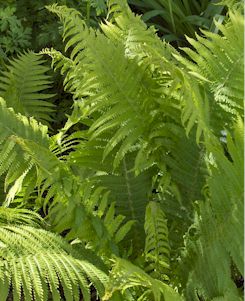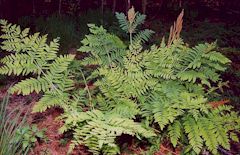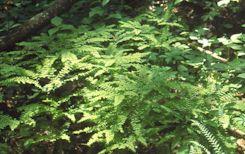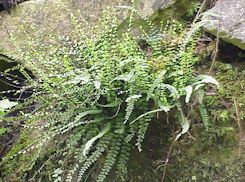|

Male Fern |
Only some few of our native Ferns are known to possess medicinal virtues, though they may all be happily pronounced devoid of poisonous or deleterious properties. As curative simples, a brief consideration will be given here to the common male and female Ferns, the Royal Fern, the Hart's Tongue, the Maidenhair, the common Polypody, the Spleenwort, and the Wall Rue. Generically, the term "fern" has been referred to the word "feather," because of the pinnate leaves, or to farr,
a bullock, from the use of the plants as litter for cattle. Ferns are termed Filices, from the Latin word filum, a thread, because of their filamentary fronds. Each of those now particularized owes its respective usefulness chiefly to its tannin; while the few more specially endowed with healing powers yield also a peculiar chemical acid "filicic," which is fatal to worms. In an old charter, A.D. 855, the right of pasturage on the common Ferns was called "fearnleswe,"
or Pascua procorum, the pasturage of swine (from fearrh, a pig). Matthiolus when writing of the ferns,. |
male and female, says, Utriusque radice sues pinguescunt. In some parts of England Ferns at large are known as "Devil's brushes"; and to bite off close to the ground the first Fern which appears in the Spring, is said, in Cornwall, to cure toothache, and to prevent its return during the remainder of the year
The common Male Fern (Filix mas) or Shield Fern, grows abundantly in all parts of Great Britain, and has been known from the times of Theophrastus and Dioscorides, as a specific remedy for intestinal worms, particularly the tape worm. For medicinal purposes, the green part of the rhizome is kept and dried; this is then powdered, and its oleo-resin is extracted by ether. The green fixed oil thus obtained; which is poisonous to worms, consists of the glycerides of filocylic and
filosmylic acids, with tannin, starch, gum, and sugar. The English oil of Male Fern is more reliable than that which is imported from the Continent. Twenty drops made into an emulsion with mucilage should be given every half-hour on an empty stomach, until sixty or eighty drops have been taken. It is imprudent to administer the full quantity in a single dose. The treatment should be thus pursued when the vigor of the parasite has been first reduced by a low diet for a couple
of days, and is lying within the intestines free from alimentary matter; a purgative being said to assist the action of the plant, though it is, independently, quite efficacious. The knowledge of this remedy had become lost, until it was repurchased for fifteen thousand francs, in 1775, by the French king, under the advice of his principal physicians, from Madame Nouffer, a surgeon's widow in Switzerland, who employed it as a secret mode of cure with infallible success. Her
method consisted in giving from one to three drams of the powdered root, after using a clyster, and following the dose up with a purge of scammony and calomel. The rhizome should not be used medicinally if more than a year old. A medicinal tincture (H.) is now prepared from the root-stock with proof spirit, in the autumn when the fronds are dying.
The young shoots and curled leaves of the Male Fern, which is distinguished by having one main rib, are sometimes eaten like asparagus; whilst the fronds make an excellent litter for horses and cattle. The seed of this and some other species of Fern is so minute (one frond producing more than a million) as not to be visible to the naked eye. Hence, on the doctrine of signatures, the plant--like the ring of Gyges, found in a brazen horse--has been thought to confer
invisibility. Thus Shakespeare says,
Henry IV., Act II., Scene 1, "We have the receipt of Fern seed; we walk invisible."
|

Bracken Fern |
Bracken or Brakes, which grows more freely than any other of the Fern tribe throughout England, is the Filix foemina, or common Female Fern. The fronds of this are branched, whilst the male plant having only one main rib, is more powerful as an astringent, and antiseptic; "the powder thereof freely beaten healeth the galled necks of oxen and other cattell." Bracken is also named botanically, Pteris aquilina, because the figure which appears in its succulent stem when cut
obliquely across at the base, has been thought to resemble a spread eagle; and, therefore, Linnaeus termed the Fern Aquilina. Some call it, for the same reason, "King Charles in the oak tree"; and in Scotland the symbol is said to be an impression of the Devil's foot. Again, witches are reputed to detest this Fern, since it bears on its cut root the Greek letter X, which is the initial of Christos.
In Ireland it is called the Fern of God, because of the belief that if |
the stem be cut into three sections, on the first of these will be seen the letter G; on the second O; and on the third D.
An old popular proverb says about this Bracken:
"When the Fern is as high as a spoon
You may sleep an hour at noon,
When the Fern is as high as a ladle
You may sleep as long as you're able,
When the Fern is looking red
Milk is good with faire brown bread."
The Bracken grows almost exclusively on waste places and uncultivated ground; or, as Horace testified in Roman days, Neglectis urenda filix innascitur agris. It contains much potash; and its ashes were formerly employed in the manufacture of soap. The young tops of the plant are boiled in Hampshire for hogs' food, and the peculiar flavour of Hampshire bacon has been attributed to this custom. The root affords much starch, and is used medicinally. "For thigh aches"
[sciatica], says an old writer, "smoke the legs thoroughly with Fern braken."
During the Seventeenth Century it was customary to set growing Brakes on fire with the belief that this would produce rain. A like custom of "firing the Bracken" still prevails to-day on the Devonshire moors. By an official letter the Earl of Pembroke admonished the High Sheriff of Stafford to forbear the burning of Ferns during a visit of Charles I., as "His Majesty desired that the country and himself may enjoy fair weather as long as he should remain in those parts."
In northern climates a coarse kind of bread is made from the roots of the Brake Fern; whilst in the south the young shoots are often sold in bundles as a salad. (Some writers give the name of Lady Fern, not to the Bracken, but to the Asplenium filix foemina, because of its delicate and graceful foliage.) The Bracken has branched riblets, and is more viscid, mucilaginous, and diuretic, than the Male Fern.
Its ashes when burnt contain much vegetable alkali which has been used freely in making glass.
It was customary to "watch the Fern" on Midsummer eve, when the plant put forth at dusk a blue flower, and a wonderful seed at midnight, which was carefully collected, and known as "wish seed." This gave the power to discover hidden treasures, whilst to drink the sap conferred perpetual youth.
|

Royal Fern |
The Royal Fern (Osmunda regalis), grows abundantly in many parts of Great Britain, and is the stateliest of Ferns in its favorite watery haunts. It heeds a soil of bog earth, and is incorrectly styled "the flowering Fern," from its handsome spikes of fructification. One of its old English names is "Osmund, the Waterman"; and the white centre of its root has been called the heart of Osmund. This middle part boiled in some kind of liquor was supposed good for persons wounded,
dry-beaten, and bruised, or that have fallen from some high place. The name "Osmund" is thought to be derived from os, |
the mouth, or os, bone, and mundare, to cleanse, or from gross mond kraut, the Greater Moonwort; but others refer it to Saint Osmund wading a river, whilst bearing the Christ on his shoulders. The root or rhizome has a mucilaginous slightly bitter taste. The tender sprigs of the plant at their first coming are "good to be put into balmes, oyles, and
healing plasters." Dodonoeus says, "the harte of the root of Osmonde is good against squattes, and bruises, heavie and grievous falles, and whatever hurte or dislocation soever it be." "A conserve of these buds," said Dr. Short of Sheffield, 1746, "is a specific in the rickets; and the roots stamped in water or gin till the liquor becometh a stiff mucilage, has cured many most deplorable pains of the back, that have confined the distracted sufferers close to bed for
several weeks." This mucilage was to be rubbed over the vertebrae of the back each night and morning for five or six days together. Also for rickets, "take of the powdered roots with the whitest sugar, and sprinkle some thereof on the child's pap, and on all his liquid foods." "It maketh a noble remedy," said Dr. Bowles, "without any other medicine." The actual curative virtues of this Fern are most probably due to the salts of lime, potash, and other earths, which it derives
in solution from the bog soil, and from the water in which it grows. On July 25th it is specially dedicated to St. Christopher, its patron saint.
The Hart's Tongue or Hind's Tongue, is a Fern of common English growth in shady copses on moist banks, it being the Lingua cervina of the apothecaries, and its name expressing the shape of its fronds. This, the Scolopendrium vulgare, is also named "Button-hole," "Horse tongue;" and in the Channel Islands "Godshair." The older physicians esteemed it as a very valuable medicine; and Galen gave it for diarrhoea or dysentery. By reason of its tannin it will restrain bleedings,
"being commended," says Gerard, "against the bloody flux." People in rural districts make an ointment from its leaves for burns and scalds. It was formerly, in company with the common Maidenhair Fern, one of the five great capillary herbs. Dr. Tuthill Massy advises the drinking, in Bright's disease, of as much as three half-pints daily of an infusion of this Fern, whilst always taking care to gather the young shoots. Also, in combination (H.) with the American Golden Seal (Hydrastis
canadensis). the Hart's Tongue has served in not a few authenticated cases to arrest the progress of that formidable disease, diabetes mellitus. Its distilled water will quiet any palpitations of the heart, and will stay the hiccough; it will likewise help the falling of the palate (relaxed throat), or stop bleeding of the gums if the mouth be gargled therewith.
From the Ophioglossum vulgatum, "'Adder's tongue,' or 'Christ's Spear,' when boiled in olive oil is produced a most excellent greene oyle. Or rather a balsam for greene wounds, comparable to oyle of St. John's Wort; if it doth not far surpasses it." A preparation from this plant known as the "green oil of charity," is still in request as a vulnerary, and remedy for wounds.
|

Maidenhair Fern |
The true Maidenhair Fern (Adiantum capillus veneris), of exquisite foliage, and of a dark crimson color, is a stranger in England, except in the West country. But we have in greater abundance the common Maidenhair (Asplenium trichomanes), which grows on old walls, and which will act as a laxative medicine; whilst idiots are said to have taken it remedially, so as to recover their senses. The true Maidenhair is named Adiantum, from the Greek: "Quod denso imbre cadente
destillans foliis tenuis non insidet humor", "Because the leaves are not wetted even by a heavily falling |
shower of rain." "In vain," saith Pliny, "do you plunge the Adiantum into water, it always remains dry." This veracious plant doth "strengthen and embellish the hair." It, occurs but rarely with us; on damp rocks, and walls near the sea. The Maidenhair is called Polytrichon because it brings forth a multitude of hairs; Calitrichon because it produces black
and faire hair; Capillus veneris because it fosters grace and love.
From its fine hairlike stems, and perhaps from its attributed virtues in toilet use, this Fern has acquired the name of "Our Lady's Hair" and "Maria's Fern." "The true Maidenhair," says Gerard, "maketh the hair of the head and beard to grow that is fallen and pulled off." From this graceful Fern a famous elegant syrup is made in France called Capillaire; which is given as a favorite medicine in pulmonary catarrh. It is flavored with orange flowers, and acts as a
demulcent with slightly stimulating effects. One part of the plant is gently boiled with ten parts of water, and with nineteen parts of white sugar. Dr. Johnson says Boswell used to put Capillaire into his port wine. Sir John Hill instructed us that (as we cannot get the true Maidenhair fresh in England) the fine syrup made in France from their Fern in perfection, concocted with pure Narbonne honey, is not by any means to be thought a trifle, because barley water,
sweetened with this, is one of the very best remedies for a violent cold. But a tea brewed from our more common Maidenhair will answer the same purpose for tedious coughs. Its leaves are sweet, mucilaginous, and expectorant, being, therefore, highly useful in many pulmonary disorders.
The common Polypody Fern, or "rheum-purging Polypody" grows plentifully in this country on old walls and stumps of trees, in shady places. In Hampshire it is called "Adder's Tongue," as derived from the word attor, poison; also Wall-fern, and formerly in Anglo-Saxon Ever-fern, or Boar-fern. In Germany it is said to have sprung from the Virgin's milk, and is named Marie bregue. The fresh root has been used successfully in decoction, or powdered, for melancholia;
also of late for general rheumatic swelling of the joints. By the ancients it was employed as a purgative. Six drachms by weight of the root should be infused for two hours in a pint of boiling water, and given in two doses. This is the Oak Fern of the herbalists; not that of modern botanists (Polypodium dryopteris); it being held that such Fern plants as grew upon the roots of an oak tree were of special medicinal powers, Quod nascit super radices querc?t
efficacius_. The true Oak Fern (Dryopteris) grows chiefly in mountainous districts among the mossy roots of old oak trees, and sometimes in marshy places. If its root is bruised and applied to the skin of any hairy part, whilst the person is sweating, this will cause the hair to come away. Dioscorides said, "The root of Polypody is very good for chaps between the fingers." "It serveth," writes Gerard, "to make the belly soluble, being boiled in the broth of an old
cock, with beets or mallows, or other like things, that move to the stool by their slipperiness." Parkinson says: "A dram or two, it need be, of the powdered dry roots taken fasting, in a cupful of honeyed water, worketh gently as a purge, being a safe medicine, fit for all persons and seasons, which daily experience confirmeth." "Applied also to the nose it cureth the disease called polypus, which by time and sufferance stoppeth the nostrils." The leaves of the Polypody when
burnt furnish a large proportion of carbonate of Potash.
|

Spleenwort Fern |
The Spleenwort (Asplenium ceterach--an Arabian term), or Scaly Fern, or Finger Fern, grows on old walls, and in the clefts of moist rocks. It is also called "Miltwaste," because supposed to cure disorders of the milt, or spleen: |
"The Finger Fern, which being given to swine, It makes their milt to melt away in fine."
Very probably this reputed virtue has mainly become attributed to the plant, because the lobular milt-like shape of its leaf resembles the form of the spleen. "No herbe maie be compared therewith," says one of the oldest Herbals, "for his singular virtue to help the sicknesses or grief of the splene." Pliny ordered: "It should not be given to women, because it bringeth barrenness." Vitruvius alleged that in Crete the flocks and herds were found to be without spleens, because
they browsed on this fern. The plant was supposed when given medicinally to diminish the size of the enlarged spleen or "ague-cake."
The Wall Rue (Ruta muraria) is a white Maidenhair Fern, and is named by some "Salvia vitoe". It is a small herb, somewhat nearly of the color of Garden Rue, and is likewise good for them that have a cough, or are shortwinded, or be troubled with stitches in the sides. It stayeth the falling or shedding of the hair, and causeth them to grow thick, fair, and well colored. This plant is held by those of judgment and experience, to be as effectual a capillary herb as any
whatever. Also, it helpeth ruptures in children. Matthiolus "hath known of divers holpen therein by taking the powder of the herb in drink for forty days together." Its leaves are like those of Rue, and the Fern has been called Tentwort from its use as a specific or sovereign remedy for the cure of rickets, a disease once known as "the taint."
The generic appellations of the several species of Ferns are derived thus: "Aspidium", from aspis, a shield, because the spores are enclosed in bosses; Pteris, from pteerux, a wing, having doubly pinnate fronds; or from pteron, a feather, having feathery fronds; Scolopendrium, because the fructification is supposed to resemble the feet of "Scoltpendra", a genus of mydrapods; and "Polypody", many footed, by reason of the pectinate fronds.
There grows in Tartary a singular polypody Fern, of which the hairy foot is easily made to simulate in form a small sheep. It rises above the ground with excrescences resembling a head and tail, whilst having four leg-like fronds. Fabulous stories are told about this remarkable Fern root; and in China its hairy down is so highly valued as a styptic for fresh bleeding cuts and wounds, that few families will be without it. Dr. Darwin, in his "Loves of the Plants", says about
this curious natural production, the "Polypodium Barometz":
"Cradled in snow, and fanned by Arctic air Shines, gentle Barometz, thy golden hair; Rooted in earth each cloven hoof descends, And found and round her flexile neck she bends: Crops the green coral moss, and hoary thyme, Or laps with rosy tongue the melting rime; Eyes with mute tenderness her distant dam, Or seems to bleat--a vegetable Lamb."
Herb Simples
The Primitive Simplers presented here show the way of life in other generations, it is not suggested or recommended trying them yourself. |
|
Garden
Herbs
Home
History of Herbs
Herb Gardening
Herbs for Beginners
Drying & Preserving Herbs
Indoor Herb Gardening
Herb Garden
Hints & Tips
Herbal
Cooking
Herb Chart
Using Herbs
Culinary Herbs
Herb
Oil and Vinegar
Herb Teas
Herb Candy
Herb Jelly
Herb Simples
Preface
Introduction
Alphabetical Listing

Trade
Recipes Online
Share your Recipes with others!!
|






